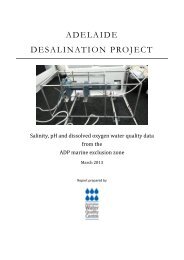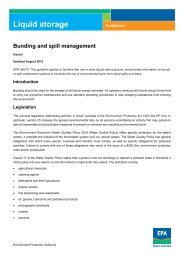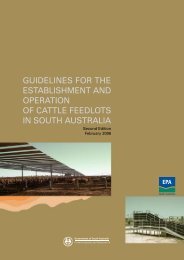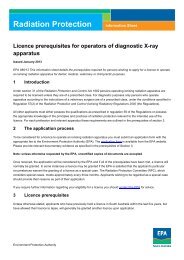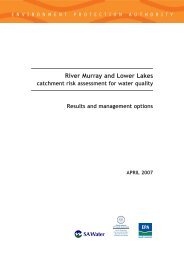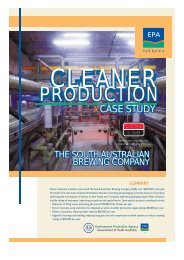Commercial Chicken Farms and Processors - EPA
Commercial Chicken Farms and Processors - EPA
Commercial Chicken Farms and Processors - EPA
You also want an ePaper? Increase the reach of your titles
YUMPU automatically turns print PDFs into web optimized ePapers that Google loves.
Review of On-Farm Disposal Treatment Risks <strong>and</strong> the Potential for Recycling of Wastes<br />
Produced from <strong>Commercial</strong> <strong>Chicken</strong> <strong>Farms</strong> <strong>and</strong> <strong>Processors</strong><br />
that storage, transportation, application, <strong>and</strong> disease prevention are considered in<br />
the management of poultry <strong>and</strong> manure. If litter is improperly spread on fields at<br />
rates in excess of what crops can use or soil can hold, excess nutrient can be lost to<br />
surface <strong>and</strong> groundwater. In recognition of this issue, farmers in the United States<br />
are urged to assess the nutrient value of the poultry manure to ensure that l<strong>and</strong> with<br />
an existing level of high nutrients does not receive high nutrient poultry litter.<br />
It is also recognised in the poultry farming industry that the direct application of<br />
litter <strong>and</strong> manure material by market gardeners has been banned by some States in<br />
the United States. Companies such as Foodl<strong>and</strong> <strong>and</strong> Safeway in Australia are also<br />
increasingly concerned about the direct application of animal manure by their<br />
contract market gardeners, due to potential food contamination <strong>and</strong> food safety<br />
requirements. Given these trends, it is likely that direct use of uncomposted<br />
materials in the horticulture industry will be restricted in the future <strong>and</strong> may not<br />
remain an option.<br />
Environmental <strong>and</strong> Health Considerations<br />
6.7 Incineration<br />
¢ water pollution, vermin infestation, dust <strong>and</strong> odour due to the storage of the<br />
waste prior to transfer<br />
¢ odour, dust <strong>and</strong> leaking of waste fluids associated with the transport of the<br />
waste<br />
¢ biosecurity requirements for collection of the waste<br />
¢ loss of amenity by adjoining l<strong>and</strong> owners<br />
¢ fire risk with inappropriate storage of the litter material<br />
¢ inappropriate application of the litter/manure material, causing<br />
environmental pollution from high nutrient concentrations<br />
¢ inappropriate application of the litter/manure material, causing pathogen<br />
contamination on food produce, <strong>and</strong> the potential spread of disease.<br />
Incineration is an accepted method of treating chicken industry waste in the United<br />
States. This practice is not common in Australia as it is not an economically viable<br />
option. On-farm incinerators are used in the United States, yet are recognised as<br />
expensive to operate properly in order to prevent smoke <strong>and</strong> odour. Incinerators<br />
used on poultry farms in the United States are required to comply with<br />
environmental specifications.<br />
Page 15




